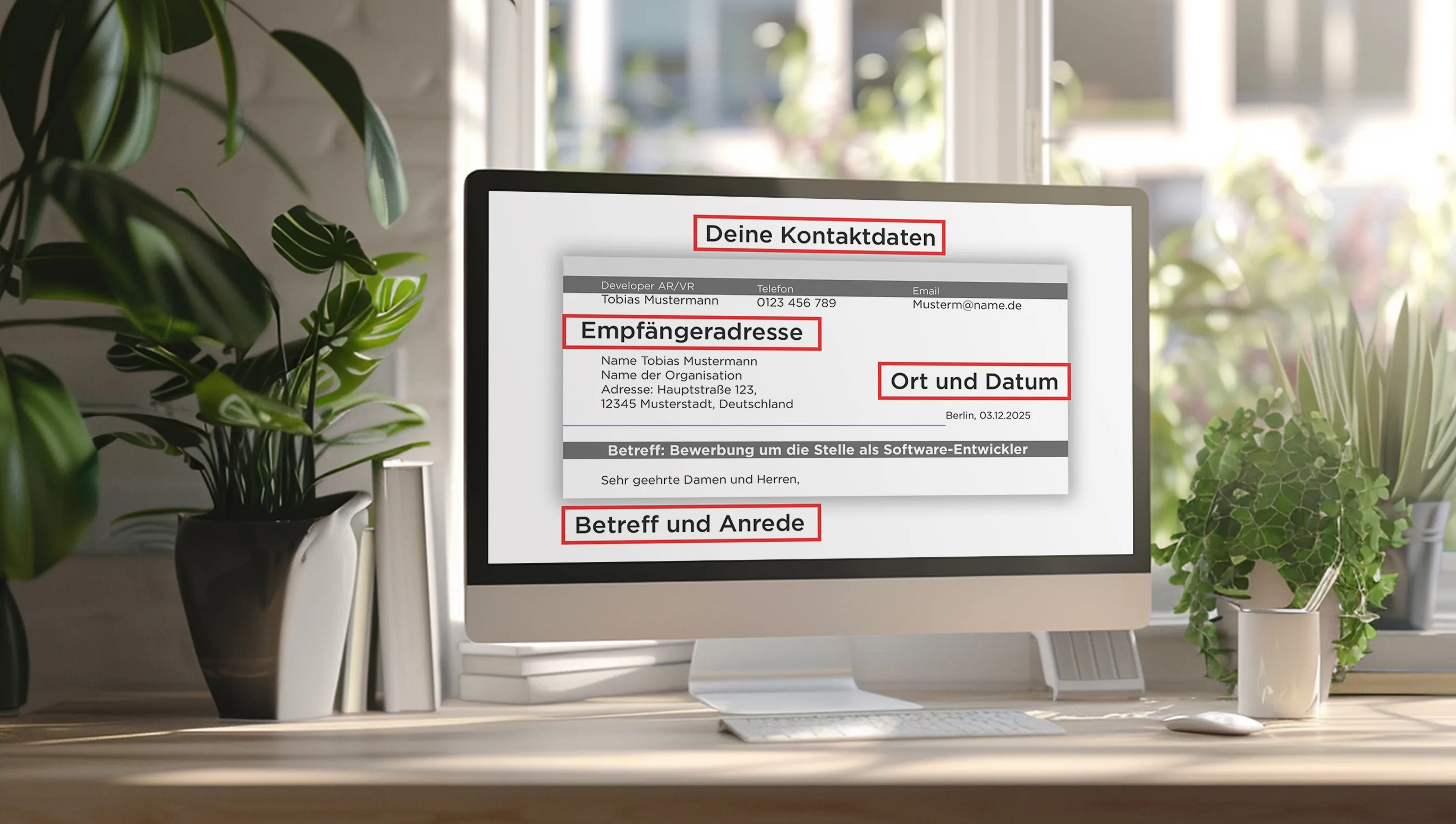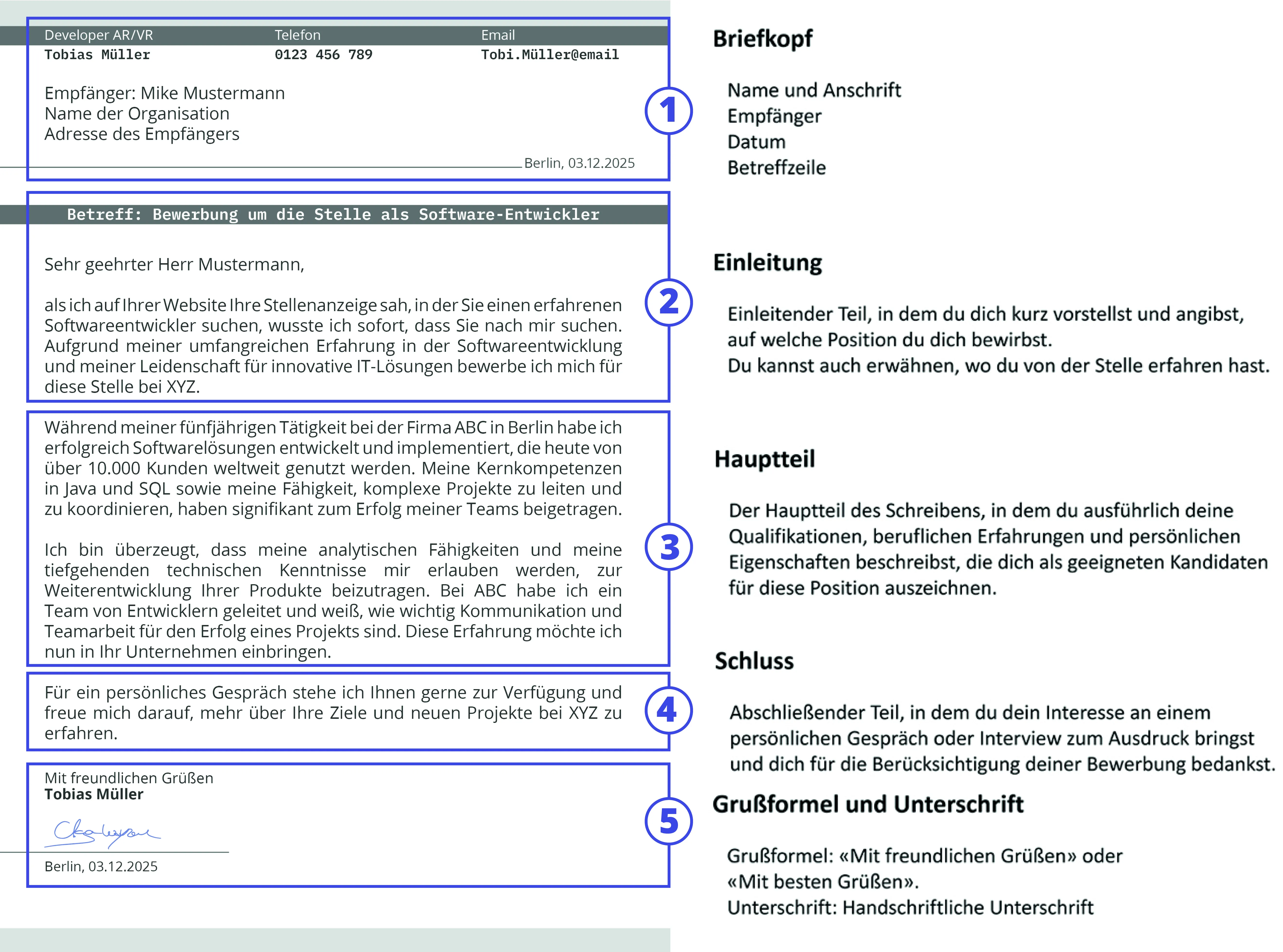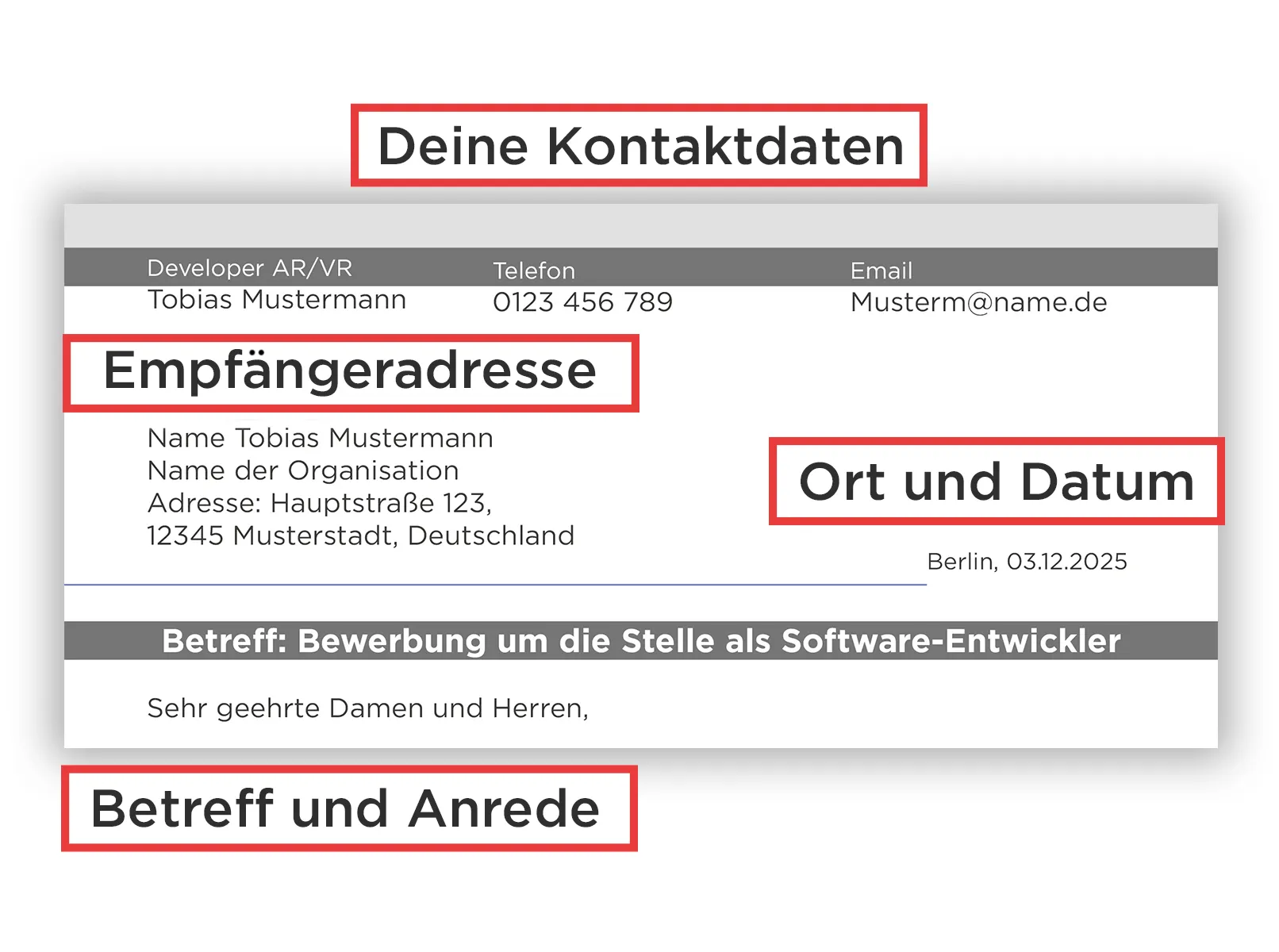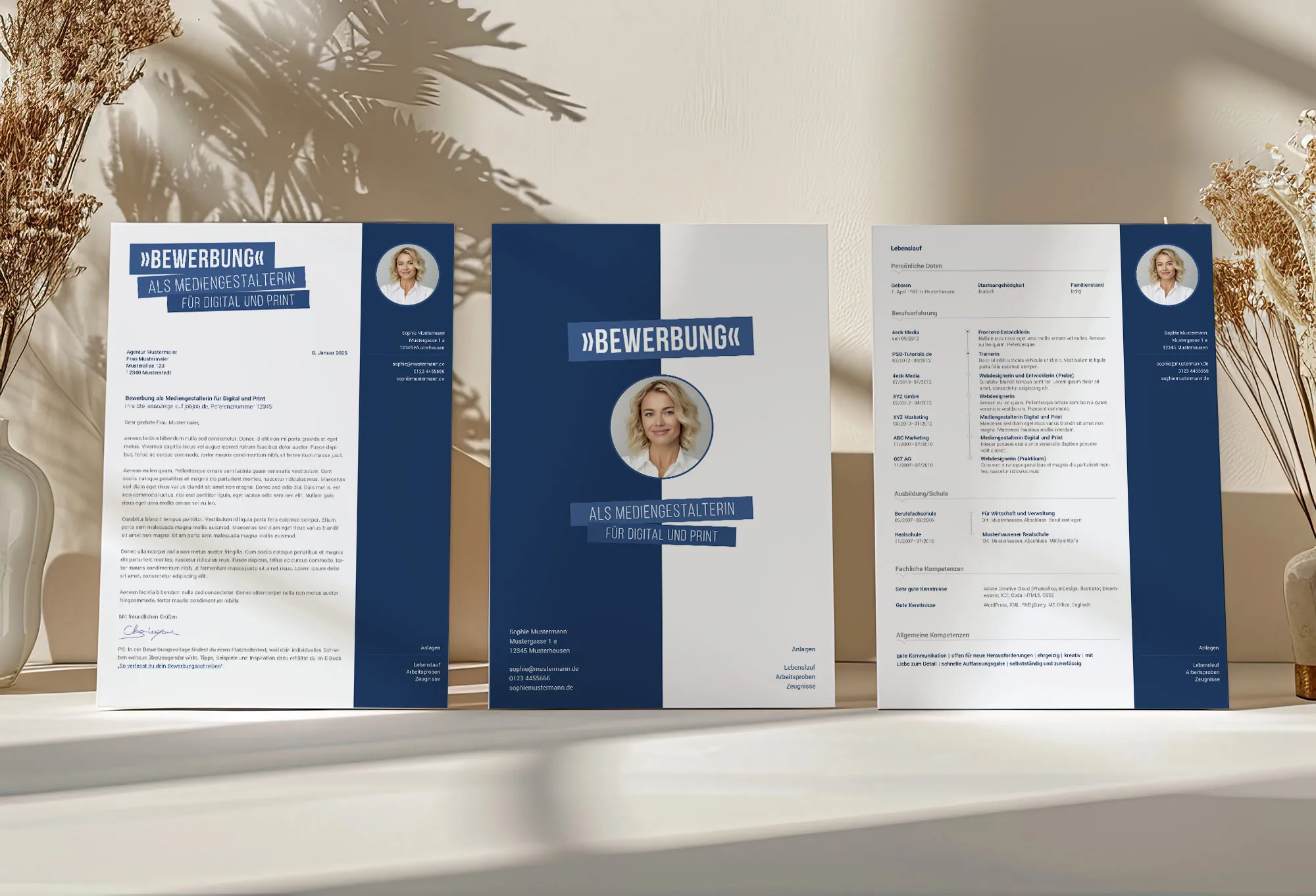When writing a cover letter, the letterhead is an essential component that leaves the first impression. Although the design of a cover letter can vary greatly – from simple and classic to modern and creative – the structural structure of a cover letter generally remains the same. The letterhead forms the beginning of every cover letter and contains important information such as the name and contact details of the applicant, the date, and the address of the company. A well-designed letterhead ensures clarity and professionalism, allowing the reader to quickly identify who is applying and how they can be reached.

Before you start reading this article about the structure of a cover letter, I would like to provide you with a schematic representation of its structure and links to pages with articles about other parts of a cover letter. This resource will help you optimize your cover letter.

- Letterhead of a cover letter. In the letterhead, you include your contact information: name, address, phone number, email address. On the right side, you note the date. On the left side, you include the recipient's contact information: name, position, company, and address.
- Introduction of a cover letter. Start with a strong introductory sentence that shows your interest in the position and the company. Optionally, briefly mention how you came across the job advertisement. Example: The aroma of freshly ground coffee, the gentle hissing of the steam wand, and the art of extracting the best from every bean – all this has fascinated me for a long time. After [number of years] years working in the gastronomy sector and gaining a lot of experience with the coffee machine, I now want to bring this passion as a barista to your establishment..
- Main body of a cover letter. Describe your relevant qualifications and experiences. Explain why you are the ideal candidate for the position, and highlight specific achievements or skills that align with the company. For example: In my previous role, I have not only perfected various coffee brewing methods but also learned how important direct interaction with guests is. Competent advice and friendly service are just as essential to me as the quality of the coffee itself. The exchange with colleagues and customers about their individual preferences and tastes was particularly valuable to me.
- Conclusion of a cover letter. Summarize why you are suitable for the position and express your anticipation for a personal interview. Example: I look forward to contributing my skills and knowledge to your team and together igniting the coffee passion of your guests. Let's discuss our common future in a personal conversation.
- Closing formula and signature of a cover letter. End the cover letter with a polite closing formula like "Yours sincerely,". Allow space for your handwritten signature and write your name below.
Letterhead of a cover letter
Here is a schematic example of how the letterhead of a cover letter should look. The letterhead contains the following elements:
- Contact information
- Recipient
- Location and current date
- Subject line
- Greeting

Contact Information in a Cover Letter
Contact information is an essential part of a cover letter and is located at the top of the letterhead. Its purpose is to provide the employer with key information about the applicant and ensure rapid contact if necessary. Contact information includes the full name, address, phone number, and email address. A clear and organized presentation of contact information ensures easy recognition at first glance and avoids misunderstandings. Up-to-date and accurate details prevent difficulties in communication.
Here is an example of correctly filled contact information:
Max Mustermann
Musterstraße 123
12345 Musterstadt
Phone: 01234 567890
Email: max.mustermann@example.com
Recipient in a Cover Letter
The recipient section in a cover letter is as crucial as the applicant's contact information. Here, you provide the contact details of the company or individual to whom the cover letter is addressed. This information is placed right below the applicant's contact information and contributes to the clarity and professionalism of the letter. The recipient section should include the full name of the contact person, the position, the company name, and the complete address of the company. Thorough research to find the right contact person demonstrates dedication and interest in the position.
Here is an example of correctly filled recipient data:
Human Resources Department
Example GmbH
Ms. Anna Example
Examplestraße 456
65432 Example City
Place and Date in the Cover Letter
The section for place and date in the cover letter is usually right-aligned below the recipient's contact information. This information is important for providing the document with a temporal and geographical context, which is particularly relevant for tracking and organizing applications. The date indicates when the letter was written, and the place indicates where it was sent from. These details convey professionalism and structure.
Here is an example of specifying place and date:
Berlin, 12th June 2024
Subject Line in the Cover Letter
The subject line in the cover letter is a central component that immediately clarifies to the recipient the purpose of the communication. It is placed between the place and date and the salutation and should be clear and concise. A well-formulated subject line specifies the reason for writing, such as applying for a specific position, and can also include the reference number of the job advertisement. This enables the reader to directly classify the letter and efficiently process it.
Here is an example of a meaningful subject line:
Subject: Application for Marketing Manager (Reference Number: 12345)
Salam Eimmm in the Cover Letter
The salam eimmm in the covering letter is the first direct contact with the recipient and should therefore be particularly courteous and respectful in its formulation. A personal salutation shows that the applicant has engaged with the company and the advertised position. Ideally, use the name of the contact person, which can be obtained either from the job advertisement or through a brief research. If the name of the contact person is unknown, a general but still polite salutation is appropriate.
Here are examples of salutations:
- Dear Ms. Müller,
- Dear Mr. Schmidt,
- Dear Sir or Madam, (if no specific contact person is known)

Letterhead and DIN 5008
A correctly formatted letterhead immediately conveys a professional impression and should therefore not be underestimated. Pay attention to the formalities and create the letterhead carefully.
For the letterhead of your application, it is recommended to follow the guidelines for business letters. Although there are no fixed rules, the DIN 5008 standard offers helpful recommendations for the formatting of letters to make them uniform and reader-friendly. This standard contains guidelines for page and line spacing, blank lines and paragraphs, and precisely specifies which information belongs in which lines. This way, the reader immediately knows where to find which information.
You can find detailed instructions for formatting the letterhead according to DIN 5008 on our subpage about Application according to the DIN 5008 standard. This standard is particularly important if you are applying for legal or commercial professions or approaching very conservative companies. By following the standard in the cover letter, you show the employer that you are familiar with the common rules.
If you are sending your application folder by post in a C4 envelope, the standard also ensures that the recipient is visible in the window of the envelope. This saves time and ensures a tidy appearance.
Although the DIN 5008 standard is not a binding regulation, it provides a good orientation. You can deviate from it and make your cover letter more individual, as long as it remains clearly structured and reader-friendly.
Based on the DIN standard, we recommend the following settings for the letterhead and cover letter:
- Line spacing: 1 to 1.5 times. This ensures sufficient space between the lines and improves readability.
- Font size: 10 to 12 point. The font should be easy to read without appearing too large or too small.
- Font: Choose a legible font such as Montserrat, Lato, Ubuntu, or Roboto. These fonts are modern yet professional.
- Font color: Black or very dark gray tones. These colors convey professionalism and are easy to read.
We are very pleased that this article has helped you. We are committed to supporting you on your journey to a successful application. From the bottom of our hearts, we wish you to find a job soon that brings you joy and where you can fully utilize your skills. A well-designed letterhead is an important step on this path, and we hope that our tips have helped you with that. Good luck with your job search and all the best for your professional future!
FAQs on the letterhead of a cover letter
1. What should be included in the letterhead of a cover letter?
The letterhead should include the applicant's contact information, the recipient's contact information, location and date, the subject line, and the salutation.
2. Why is the letterhead important in a cover letter?
A well-designed letterhead leaves a professional first impression and makes it easier for the recipient to identify and contact the sender.
3. How should I format the contact information in the letterhead?
The contact details should include name, address, phone number, and email address. They are located in the upper area of the letter, aligned to the left.
4. How can I find the right contact person for the recipient area?
The name of the contact person can often be found in the job advertisement or through a brief search on the company's website.
5. What should I do if I do not know the contact person?
Use a general salutation like "Dear Sir or Madam," if the name of the contact person is unknown. But hey, why not just call the company and inquire? This way, you also have a starting point in the cover letter.
6. How should I format the location and date?
The location and date should be right-aligned above the motivational text, e.g., "Berlin, June 12, 2025".
7. What font and size should I use?
Use a legible font like Montserrat, Lato, Open Sans, or Roboto in a size of 10 to 12 point.
8. Should I adhere to the DIN 5008 standard for my cover letter?
The DIN 5008 standard is recommended, especially for legal and business professions, as well as in conservative companies.
9. Can I deviate from the DIN 5008 standard?
Yes, as long as the cover letter remains clearly structured and reader-friendly, you can adjust the layout individually.
10. How do I correctly write the subject line?
The subject line should be clear and concise, e.g., "Application for Marketing Manager (Reference Number: 12345)".
11. What should be considered in the salutation?
A personalized salutation with the name of the contact person is ideal. If the name is unknown, use "Dear Sir or Madam,".
12. How should I design the letterhead if I am sending the application via email?
Even in email applications, the contact details, recipient, location and date, and subject line should be clearly structured.
13. What color should the font be?
Use a professional and easily readable color such as black or dark gray.
14. How much spacing should there be between the lines?
A line spacing of 1 to 1.5 times ensures good readability.
15. Do I need to provide the full address of the company?
Yes, a complete address with street, house number, postal code, and city is required.
16. Should I write my name in the letterhead?
Yes, your full name should be provided along with the other contact details.
17. How important is the location in the letterhead?
The location indicates where the letter was sent from and is one of the basic details in the letterhead.
18. What should I do if my contact details change?
Make sure all the information in the letterhead is up to date before sending out the application.
19. Can I also design the letterhead creatively?
Yes, as long as the important information remains clear and reader-friendly, the letterhead can be individually and creatively designed.
20. How do I check if my letterhead is correct?
Compare your letterhead with an example from DIN 5008 or have it reviewed by a second person to ensure that all details are correct and easily readable.
Cover letter for job application: Instructions, tips & examples
From Vitalii Shynakov
